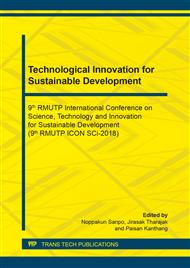[1]
Center for hazards & risk research at Columbia university, Thailand Natural Disaster Profile,, 2005. [Online]. Available: https://www.ldeo.columbia.edu/chrr/research/profiles/thailand.html.
Google Scholar
[2]
RECOFTC Bangkok Regional Office, About ING Project,, [Online]. Available: https://www.recoftc.org/thailand/projects/ing/about/about-ing-project.
Google Scholar
[3]
S. Srimuang, Life in Ing basin" 12 May 2016. [Online]. Available: lek-prapai.org/home/ view.php,id=545.
Google Scholar
[4]
Hydro and Agro Informatics Institute, Kok river basin, 2012. [Online]. Available: http://www.thaiwater.net/web/attachments/25basins/03-kok.pdf.
Google Scholar
[5]
T. Homdee, K. Pongput and S. Kanaeb, A comparative performance analysis of three standardized climatic drought indices in the Chi River basin, Thailand,, Agriculture and Natural Resources, vol. 50, no. 3, pp.211-219, (2016).
DOI: 10.1016/j.anres.2016.02.002
Google Scholar
[6]
M. Thilakarathne and V. Sridhar, Characterization of future drought conditions in the Lower Mekong River Basin,, Weather and Climate Extremes, vol. 17, pp.47-58, (2017).
DOI: 10.1016/j.wace.2017.07.004
Google Scholar
[7]
S. Prabnakorn, S. Maskey, F.X. Suryadi and C. Fraiture, Rice yield in response to climate trends and drought index in the Mun River Basin, Thailand,, Science of The Total Environment, vol. 621, pp.108-119, (2018).
DOI: 10.1016/j.scitotenv.2017.11.136
Google Scholar
[8]
M. G. a. X. M. T. Na-U-Dom, Ecosystem Resilience to Drought and Temperature Anomalies in the Mekong River Basin,, IOP Conf. Series: Earth and Environmental Science, vol. 68, (2017).
DOI: 10.1088/1755-1315/68/1/012012
Google Scholar
[9]
R.G. Allen, L.S. Pereira, D. Raes and M. Smith, Crop Evapotranspiration: Guidelines for Computing Crop Requirements, Irrigation and Drainage, Roma, Italia: FAO, (1998).
Google Scholar
[10]
M. I. Ahmad, C. D. Sinclair and A. Werritty, Log-logistic flood frequency analysis,, J. Hydrol., vol. 98, p.205–224, (1988).
DOI: 10.1016/0022-1694(88)90015-7
Google Scholar
[11]
V. P. Singh, H. Guo and F. X. Yu, Parameter estimation for 3-parameter log-logistic distribution (LLD3),, Pome. Stochastic Hydrol. Hydraul., vol. 7, pp.163-177, (1993).
DOI: 10.1007/bf01585596
Google Scholar
[12]
M. Abramowitz and I. A. Stegun, Handbook of Mathematical Functions, with Formulas, Graphs, and Mathematical Tables, Dover Publications, (1965).
DOI: 10.2307/1266136
Google Scholar
[13]
C.W. Thornthwaite, An approach toward a rational classification of climate.,, Geographical Review, vol. 38, pp.55-94, (1948).
DOI: 10.2307/210739
Google Scholar
[14]
S. Begueria and M. Sergio, Package 'SPEI',, [Online]. Available: https://cran.r-project.org/web/packages/SPEI/SPEI.pdf.
Google Scholar
[15]
J. Keyantash, The Climate Data Guide: Standardized Precipitation Index (SPI).,, National Center for Atmospheric Research Staff (Eds), 8 March 2018. [Online]. Available: https://climatedataguide.ucar.edu/climate-data/standardized-precipitation-index-spi.
DOI: 10.5194/egusphere-egu2020-454
Google Scholar
[16]
M. Svoboda, M. Hayes and D. Wood, Standardized Precipitation Index User Guide, Geneva: World Meteorological Organization, (2012).
Google Scholar
[17]
S. Kirtsaeng and P. Chantraket, Investigation of Z-R Relationships for Monsoon Seasons over Southern Thailand,, Appl. Mech. Mat., vol. 855, pp.159-164, (2016).
DOI: 10.4028/www.scientific.net/amm.855.159
Google Scholar
[18]
S. Kirtsaeng, P. Sukthawee, B. Khosuk, F. Masthawee, N. Pantong , and K. Taorat, Development of daily temperature prediction model for Northeastern Thailand using artificial neural networks.,, KKU. Eng. J., vol. 43(S3), pp.487-490, (2016).
Google Scholar
[19]
S. Kirtsaeng, J. Kreasuwun, S. Chantara, P. Sukthawee and F. Masthawee, Weather Research and Forecasting (WRF) Model Performance for a Simulation of the 5 November 2009 Heavy Rainfall over Southeast of Thailand,, Chiang Mai J. Sci., vol. 39(3), pp.511-523, (2012).
Google Scholar
[20]
P. Sukthawee and S. Kirtsaeng, Comparison of rainfall pattern and statistical verification of CPS for extreme rainfall simulation on 13 April 2013,, IEEE Conferences on 2015 International Conference on Science and Technology (TICST), pp.481-488, (2015).
DOI: 10.1109/ticst.2015.7369403
Google Scholar


